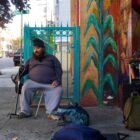More than 100 protesters enjoyed a beautiful sunny Tuesday afternoon in the shadow of one of the most toxic plots of land in California.
The group gathered at the gates of the old Hunters Point Naval Shipyard to voice their concerns that Lennar Corp., which is developing the former maintenance base into a residential complex, could leave the area even more toxic, and that the U.S. Navy plans to cap and seal the radioactive Parcel E2 area of the shipyard.
"Don’t cap! Clean!" protesters shouted as speakers explained the Navy’s intentions.
Tessie Ester, a Bayview resident and community organizer, said she is faced every day with a sick child or a child with a bloody nose, which she attributes to the toxic pollution of the shipyard.
“That’s why we are here today,” Ester said. “We’re asking them not to cap, but to clean it. I grew up here as a kid. I watched my father work here. I worked in the shipyard. There’s lots of toxins in there.”
“All we want is clean air and for them to clean up these toxins, she added. “It’s time for it to be done now.”
The Bay Area Air Quality Management District fined Lennar $515,000 in 2008 over the company’s failure to monitor asbestos dust released by the Hunters Point project. Inhaled asbestos causes cancer.
Lennar and the Navy did not answer requests for comment.
Gordon Mar, director of the Bay Area Environmental Health Collaborative, said the Hunter’s Point Shipyard situation highlights the need for environmental regulators to assess the cumulative impact of the risks.
“I think all the test they have done are based on hypothetical data,” Mar said. “They treated this development project as if it was out in a pristine environment. And doesn’t take into account the years or decades of the worst environmental pollution in San Francisco that these people are living under right now.”
The U.S Navy operated Hunters Point as a shipbuilding and repair facility from 1941 until 1976 on 936 acres of land and water. After 1976 the Navy leased the shipyard to a private ship-repair company.
|
|
| The group erected a "Stop Work Order" in the street. Photo by Hank Drew/The Public Press. |
In 1989, the U.S. Environmental Protection Agency declared the shipyard a Superfund site after discovering PCBs, solvents, pesticides, petroleum hydrocarbons and lead on the site.
John Rizzo, from the Sierra Club, compared the Hunter’s Point development project with another undeveloped area of San Francisco.
“What if Mayor Newsom wanted to take 40 acres of land from Golden Gate Park,” Rizzo said. “They wouldn’t be in the same predicament.”
“Only here would they have the audacity to try something like that,” he added.
Eric Brooks of the San Francisco Green Party noted the lack of media coverage at the event. No cameras or reporters from the major networks or newspapers were present.
“Complaints from the black community go mostly unheard,” Brooks said. “A citywide movement needs to rise up if we are going to do something about Lennar.”
Once the speakers concluded, the group gathered around the entrance to the shipyard and chained themselves to a giant “Stop Work Order” sign they placed in the middle of the road.
An 80-year-old Bayview resident was bound by the chain. Davu Flint, Bayview Organizing Project Organizer for POWER, was involved with the negotiations with keeping Lennar involved in the Hunters Point development project. He said he was "disgusted" with Lennar’s corporate attitudes.
Davu Flint, Bayview Organizing Project representative for POWER, was involved with the negotiations keeping Lennar involved in the Hunters Point development project. He said he was disgusted with Lennar’s attitudes.
“Going into boardroom meetings with them and seeing their environmental practices — seeing their bottom-line profit margins — that is all they care about,” Flint said.
“I love this community and have been coming here since I was a child,” he added. “They promised us 30 percent affordable housing, and they have found a way to weasel out of that. I decided to take an organizing job with POWER to combat their avaricious practices.”
Flint was also disturbed by the possibility that the U.S. Navy — after dissolving the the Hunters Point Shipyard Restoration Advisory Board, the civilian organization in charge of overseeing the Navy’s cleanup efforts, last month — could decide to just cap and seal the radioactive Parcel E2.
“If I have a sink full of dirty dishes and I throw a tower over it, I’ve still got dirty dishes,” he said. “I may not be able to see that dirt, but it is still there. The same goes for cap and seal. It is the cheapest way and best for them. But, it is bad for the community.”
No representatives of Lennar Corporation, the U.S. Navy or San Francisco city government attended the rally, which was organized by a coalition of Bay Area activist organizations such as Greenaction for Health, POWER and the San Francisco Green Party.









